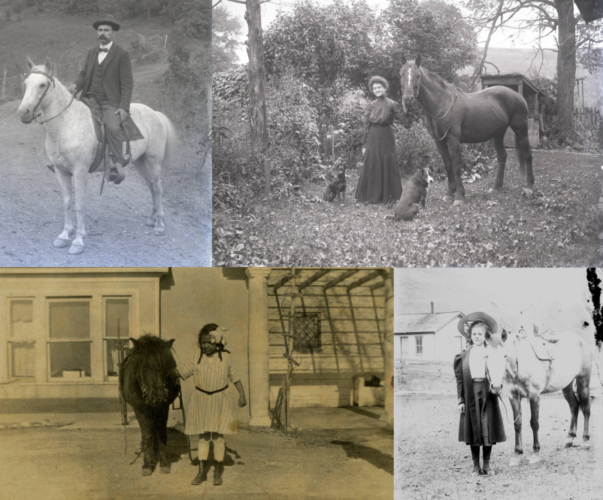Horses in Ohio Memory

On September 29, the All American Quarter Horse Congress will once again return to Columbus for the world’s largest horse show. Today’s blog post celebrates the nearly 5,000-year bond between horses and humans.
The predecessors of modern horses emerged roughly 55 million years ago in what would eventually become North America. For centuries they traveled between Asia and the Americas via the Bering Land Bridge, but they disappeared from the fossil record in the Americas about 10,000 years ago. Modern horses arrived on the scene roughly 40,000 years ago in Europe and Central Asia. New research suggests that horses were first domesticated around 2200 B.C.E., probably in the area north of the Black and Caspian Seas. It’s likely that horses were reintroduced to North America in the early 1500s, when Hernán Cortés arrived in Mexico.

Humans’ partnership with the horse was a watershed discovery. Horses allowed us to travel farther and faster, which fostered migration and trade; to hunt larger, faster game; to have greater mobility in battle; and to plow fields, transport goods and people, and otherwise provide the literal horsepower that drove society.
In the second half of the nineteenth century, a typical city street might include delivery wagons of all shapes and sizes, carriages, carts, city vehicles, and streetcars—all powered by horses. As technology advanced, the demand for horses actually grew; the US horse population increased by nearly 600% in the years between the Civil War and World War I. Firefighting is one example of the increased need for horses. Unlike hand-pumped fire engines pulled by a team of people, steam-powered fire engines could pump significantly more water—but at three to four tons, they also weighed significantly more. Enter the horse; with special harnesses, a team of fire horses could be ready to go in less than a minute.
However, life could be hard for horses, especially in larger cities. After seeing work horses being beaten in the streets, diplomat and philanthropist Henry Bergh founded the American Society for the Prevention of Cruelty to Animals in New York City in 1866. Shortly thereafter, the nation’s first effective anti-cruelty law was passed, which allowed the ASPCA to investigate cruelty complaints and make arrests. When Bergh died in 1888, every US state but one had anti-cruelty laws.

In 1915 there were roughly 20 million horses in the United States. But as the decades progressed, the internal combustion engine began to replace horses, especially as a means of transportation. However, the use of horses in agriculture persisted; horses were versatile, and farmers would often keep their horses even after purchasing a tractor.
Horses are still an important part of American culture, although today they are used mainly for entertainment and recreation. According to a 2023 Economic Impact Study by the American Horse Council, there are more than 6.5 million horses in the United States, with 1.5 million horse owners, and 12 million people that attend horse events as spectators. Last year, the Quarter Horse Congress alone had approximately 26,000 entries and attracted more than 650,000 people.
Even though the role of horses in modern society has changed, our centuries-long shared history has given us a strong bond with them. So here’s to the horse, and to a successful All American Quarter Horse Congress!
Thank you to Stephanie Michaels, Research and Catalog Services Librarian at the State Library of Ohio, for this week’s post!



Leave a Reply
You must be logged in to post a comment.